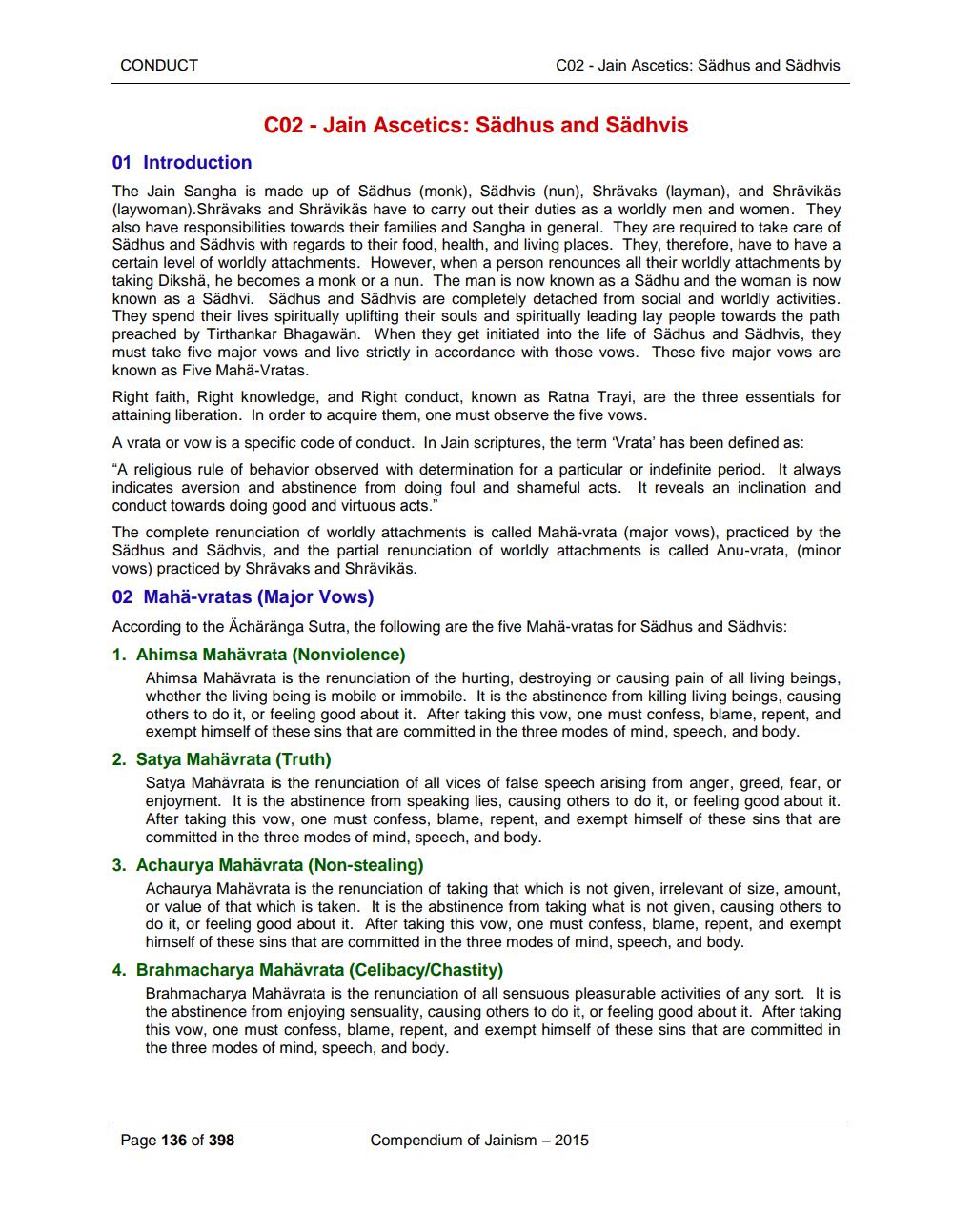________________
CONDUCT
CO2 - Jain Ascetics: Sädhus and Sadhvis
CO2 - Jain Ascetics: Sädhus and Sadhvis
01 Introduction The Jain Sangha is made up of Sädhus (monk), Sadhvis (nun), Shrävaks (layman), and Shrävikäs (laywoman). Shrävaks and Shrävikäs have to carry out their duties as a worldly men and women. They also have responsibilities towards their families and Sangha in general. They are required to take care of Sädhus and Sadhvis with regards to their food, health, and living places. They, therefore, have to have a certain level of worldly attachments. However, when a person renounces all their worldly attachments by taking Dikshä, he becomes a monk or a nun. The man is now known as a Sädhu and the woman is now known as a Sädhvi. Sädhus and Sadhvis are completely detached from social and worldly activities. They spend their lives spiritually uplifting their souls and spiritually leading lay people towards the path preached by Tirthankar Bhagawän. When they get initiated into the life of Sädhus and Sadhvis, they must take five major vows and live strictly in accordance with those vows. These five major vows are known as Five Mahä-Vratas. Right faith, Right knowledge, and Right conduct, known as Ratna Trayi, are the three essentials for attaining liberation. In order to acquire them, one must observe the five vows. A vrata or vow is a specific code of conduct. In Jain scriptures, the term 'Vrata' has been defined as: "A religious rule of behavior observed with determination for a particular or indefinite period. It always indicates aversion and abstinence from doing foul and shameful acts. It reveals an inclination and conduct towards doing good and virtuous acts." The complete renunciation of worldly attachments is called Mahä-vrata (major vows), practiced by the Sädhus and Sadhvis, and the partial renunciation of worldly attachments is called Anu-vrata, (minor vows) practiced by Shrävaks and Shrävikäs. 02 Mahä-vratas (Major Vows) According to the Achäränga Sutra, the following are the five Maha-vratas for Sädhus and Sadhvis: 1. Ahimsa Mahävrata (Nonviolence)
Ahimsa Mahävrata is the renunciation of the hurting, destroying or causing pain of all living beings, whether the living being is mobile or immobile. It is the abstinence from killing living beings, causing others to do it, or feeling good about it. After taking this vow, one must confess, blame, repent, and
exempt himself of these sins that are committed in the three modes of mind, speech, and body. 2. Satya Mahävrata (Truth)
Satya Mahävrata is the renunciation of all vices of false speech arising from anger, greed, fear, or enjoyment. It is the abstinence from speaking lies, causing others to do it, or feeling good about it. After taking this vow, one must confess, blame, repent, and exempt himself of these sins that are
committed in the three modes of mind, speech, and body. 3. Achaurya Mahävrata (Non-stealing)
Achaurya Mahävrata is the renunciation of taking that which is not given, irrelevant of size, amount, or value of that which is taken. It is the abstinence from taking what is not given, causing others to do it, or feeling good about it. After taking this vow, one must confess, blame, repent, and exempt himself of these sins that are committed in the three modes of mind, speech, and body. Brahmacharya Mahävrata (Celibacy/Chastity) Brahmacharya Mahävrata is the renunciation of all sensuous pleasurable activities of any sort. It is the abstinence from enjoying sensuality, causing others to do it, or feeling good about it. After taking this vow, one must confess, blame, repent, and exempt himself of these sins that are committed in the three modes of mind, speech, and body.
4 Bed
Page 136 of 398
Compendium of Jainism - 2015




